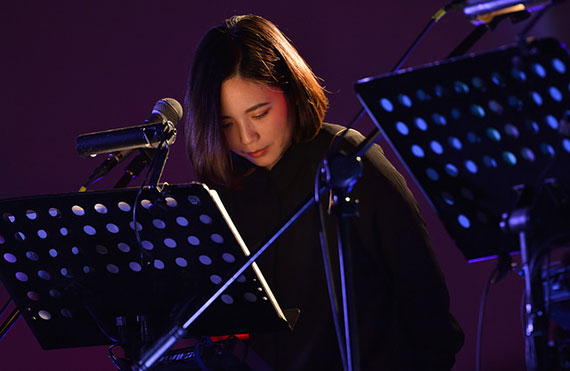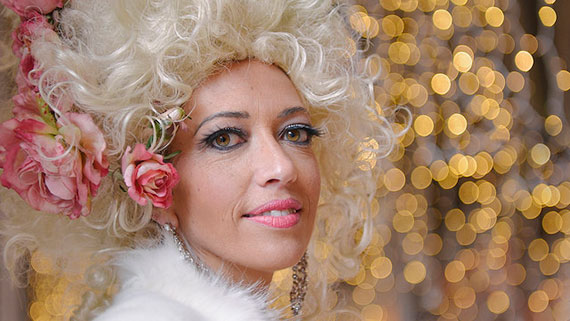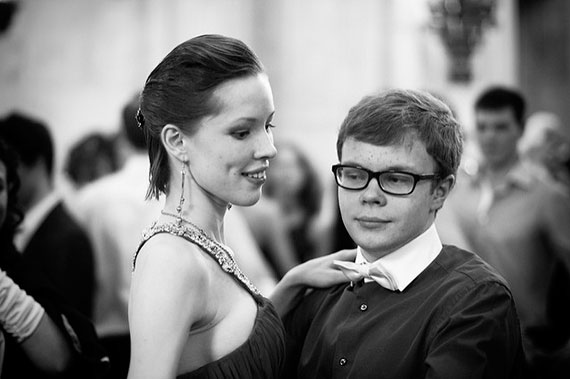There are five lenses I believe every indoor photographer must have in their kit. It doesn’t matter whether you shoot Canon or Nikon, or whether you shoot crop or full frame. These five are must haves for capturing emotion and action in low light. If you’re still using a variable speed, package zoom lens then I implore you to consider purchasing at least one high-speed lens. Both Canon and Nikon offer an identical lineup of fast glass.
In this article I want to focus on five different lenses: three prime lenses and two zoom lenses.

Photo by michael song
The intent of this article is not to argue the importance of fixed verses zoom lenses, nor is it to examine the pros and cons of each. It is intended to look at how a professional chooses and uses the best lens for the situation. Event photography, especially wedding photography, incorporates a mixture of both technical and creative photographic opportunities. It doesn’t matter if you shoot traditional or journalistic you will use techniques and compositions from both schools of thought.
For any work indoors the first thing a photographer will consider is the speed of the lens. Anything under f/2.8 is too slow for professional work. Even with the advent of relatively noise free high ISO camera sensors a professional must know that they got the shoot. You do not want to be concerned with motion blur or camera shake while great photographs pass by.
Primes
Prime lenses offer increased color accuracy and intense depth of field control. Not only that, but they have a single advantage in portrait photography that zooms do not. They offer uniformity in style. In exchange for this they give up the flexibility in composition that a zoom lens offers. You will want to use the same prime lens for all or most of your traditional portrait shots. That way there will be a certain continuity of style, tone, and feeling running through them. Simply, by limiting yourself to a single focal length you will give your images a feeling that they belong together.

Photo by Stefano Montagner; ISO 360, f/2.8, 1/125-second exposure.
Both Canon and Nikon offer beautiful prime lenses in both a mid-range and professional category. Don’t let this confuse you if you are on a budget. Both categories offer superb optics and technical features. Canon offers their primes in a standard lineup and in their L-series professional lineup, while Nikon offers their primes in the standard D-series and the professional G-series lineup. The price range for the standard lines run between $300 and $500, and the professional L-series and G-series lenses run between $1200 and $2000.
Wide
At the wind end of the spectrum a 24mm f/2.8 is available in the mid range while the professional version of these lenses offers a maximum aperture of f/1.4. These lenses are great for traditional group shoots and formal interior shoots. Using a wide angle lens like this for action shots during the main event or a wedding reception will produce photos that give the viewer the feeling that they are there immersed in the surrounding of the photograph. This style lends itself well to documentary work and photojournalistic photography.
Standard
The “nifty 50” or 50mm prime lens has traditionally found itself to be the workhorse of many professional photographers. It is offered as a 50mm f/1.4 and is well suited for portraiture and documentary work. This lens gives beautiful color saturation and intense rich blurring, or bokeh, outside of its narrow depth of field. The professional series offers a maximum aperture of f/1.2. Use this lens for close portraiture, and interior detail photography. In low light situations this lens excels at stopping the action, but be aware that the small depth of field may cause focus issues in rapidly changing subjects as they move outside of its small range.
Telephoto
For most photographers an 85mm f/1.8 lens is the ideal portraiture lens. It offers great depth of field while minimizing the foreshortening effect of the shorter primes. The lens is also offered in a professional version with a maximum aperture of f/1.2. The 85mm focal length is somewhat limiting for general purpose use but makes up for this with gorgeous traditional portrait shots. This is the lens you will use most of the time when you get the lighting gear out and pose your clients for their formal shots. The wide aperture also gives you the ability to take advantage of available lighting for soft natural portraits.
Zooms
Zooms offer one thing primes cannot. They offer the ability to compose your photograph while standing relatively in the same place. For event photography this is a big plus. You cannot always get close enough to the action for the shot that you want. Zoom lenses also give you a big advantage if you’re trying to capture candid photographs. They allow you to sneak up next to the subject without them noticing you. This makes for natural looking images and removes the observer effect from your subject.
The zoom lenses offered by both Canon and Nikon are vast. There are however, only two lenses that you need to focus on. A wide angle and a telephoto zoom. The 24-70mm f/2.8 and the 70-200mm f/2.8 are both industry standards for this type of photography. They are both professional class lenses though there are lesser priced aftermarket lenses that offer comparable optical and technical features.

Photo by Dmitry Kolesnikov; ISO 800, f/1.2, 1/250-second exposure.
Wide
The wide-angle zoom offers a range of 24-70mm and a maximum aperture of f/2.8. This lens is great for closer indoor work and detail photography. Break this one out when you will be getting close to your subjects such as a dressing room or small bar area. This also makes a great walk around lens allowing you to get moderately close for candids and yet wide enough for small shots, table and room photographs. The zoom range on this lens is within the operating specs of most on camera flash equipment making it the go-to lens for any direct flash work.
Telephoto
The telephoto zoom lens offers a range of 70-200mm and maximum aperture of f/2.8. The 70-200mm lens is offered with image stabilization (IS) Canon, or vibration reduction (VR) Nikon. This lens is also offered in a model without any anti-shake technology. The VR and IS lenses are the best choice for low light situations providing forgiveness for shake due to low shutter speed. This lens is the one you want when you need to step away from the action and blend in to capture emotion and raw candid expressions. If your style aims for a photojournalistic look and capturing the moment. This might be your all purpose lens.
About the Author:
Stephanie Smith is the owner and head photographer of omorfiPixel – Kansas City based wedding, family and newborn photography.
Like This Article?
Don't Miss The Next One!
Join over 100,000 photographers of all experience levels who receive our free photography tips and articles to stay current:






I’m shooting my first indoor event this Saturday. I have the 24-70 n the 70-200 in 2.8(both Tamron) and the 50 mm 1.8 with the 85 mm 1.8. Initially it will be portraits and group shots and then the rest of the evening will be candid shots. I’m thinking this is all I will need. What do you think??
Eddie F.
Waiting for Canon to make a bridging zoom, 35mm-155mm L 2.8 IS.
😂
At one point, I shot events every week for years, indoors, low light etc. I needed versatility, speed and zoom capabilities etc. So, I shot a 24-70 2.8 on a full frame. Never had issues, plenty sharp enough, plenty of saturation. If I went to a sporting event, like football under the lights, a 70-200 2.8. Anyhow, unless I knew exactly what I would shoot, subject, distance and many other factors, a prime might not give me what I needed. Just my opinion.
This article is written very well, unique view, I think I should put into favorites, look again
In addition, I also wrote a review of portrait lens.
http://www.johnalexpro.com/best-portrait-lenses/
Good article, thank you. But here – http://wedding-retouching.com/blog/photo-equipment/best-cameras-lenses-to-shoot-weddings.html i have recently read that Canon 35mm f/1.4L and Nikon 35mm f/1.4G are very good for different events (especially weddings) What do you think about it?
I stopped reading at the mention of Canikon. There are other good cameras out there.
I have Nikon D5300 and 18-105mm lens f 1.35-5.6
I have problem taking pictures at conferences with dark indoor lights, peopleare moving their head and mouth while speaking so most my photos turn out blurry and shaking.
I cant use flash and I cant increase my shutter speed more than 1/25
which lens do u suggest me to buy? my budget is up to $500
What kind of lens would you recommend for indoor pictures of kids at play? Can the right lens help in this regard without a flash? I seem either to not get enough light, or blur because kids don’t sit still.
Thanks for a nice article Steph.
Yes. It’s always a fast prime for indoors… and the humble ‘Nifty Fifty’ with an aperture 1.4 or lower
is the best choice … and for portraits it’s undoubtedly an 85mm f/1.4. … Amen … !!!
I can provide some of my experiences, perhaps.
Started out with the following lenses which came with the Canon 60D bundle I bought.
Canon EF-S 18mm – 55mm f 3.5 – 5.6 IS II
Pluses: Inexpensive, small, light, versatile range of focus length
M’eh: The build quality isn’t great, but it will last many years anyway.
Minuses: Images could be much sharper, cannot use in low light situations. I like to take pictures at dawn and dusk and I’d need a tripod.
Canon EF-S 55mm – 250 mm f 4 – 5.6 IS STM
Same as above, only this lens can only be used in daylight at the telephoto end.
Currently I use
Sigma 8 – 16 mm f 4-5.6
This lens is not fast but it is crazy wide on a crop camera. Great for astrophotography, but need to secure on a tripod, bump the ISO to 1000+ and take 30 s exposures.
Canon 16-35 f/2.8
I can handhold this lens at dawn and dusk and still get great shots. Not as sharp as my fast prime lenses but still pretty sharp.
Canon 24 mm f/1.4
Great for low light photography. If I can still read a book, then I can take pictures w/o flash. This has to be the lens for auroras photography where you need fast wide angle lens.
Canon 85 mm f/1.2
I’ve got a big gap between the 24 mm f/1.4 and 85 f/1.2. I got this lens because it creates headshots that cannot be duplicated. Focus is slow so the keep rate is also low. I wouldn’t use this for low light event photography unless it was a panoramic shot, because if the subject moves, I’ll miss the focus. The DOF is razor thin.
Sigma 105 mm f/2.8 macro
This lens is not fast enough for low light IMHO. It is good for isolating bugs. Now that I bought this I need to admit that I’m not into macro as much as I thought I would be.
Canon 200 mm f/2.8
If this is a secret, then it is a well kept one. I can get this little lens into any sporting venue and still get shots at a distance with the ISO bumped to 2000+. Try getting a 70-200mm f/2.8 or the less popular 200mm f/2 into the venue – you’re more likely to be stopped at the gate unless you have a media pass.
Sigma 120-300 mm f/2.8
I bought this lens because reviews said it was sharp. I’m really disappointed with the results. The MTF charts looked better than Canon’s but that hasn’t been my experience. Perhaps this is because I generally use it with Sigma’s 2x extender to make it the equivalent of a 240 – 600mm f/5.6. Perhaps I need to try it with a tripod, although didn’t think that would be a problem given I’m shooting at 1/1000 s or faster. Maybe its haze? Not sure, but now it sits in a Pellican case awaiting a day when I can be more patient with it.
I am confused to choose a prime lens or a zoom lens for general party photography. I know Prime would not offer the flexibility but the overall quality should be better..
To the first commenter… razor thin DoF requires practice to control. And for things like flowers, focus stacking is the way to go to get the crisp focus all the way through while retaining the buttery bokeh that everyone loves.
To anyone shooting the birth of a child, or infants in general…. NO FLASH is all I can say. Get fast glass. The last thing Mom will want is flashes popping in the middle of everything.
I’m looking for a few good event lenses… you’ve just confirmed what I already decided. 24-70mm and a 50mm prime.
Lenses plays very important role in indoor photography. There are various types of lenses used in photography. I am deeply interested in each single piece of facts you post here about indoor photography. Thanks.
Not only is real estate photography important, but it is also going to be vital to stage your home. This means that you are going to want all of the decor in the room to be neutral, so that it appeals to the different people that are looking at it. You will want to put away things that show you have pets, and take the pictures so that your rooms look spacious and large.
i’m going to photograph the birth of my sister’s baby- can anyone recommend what type of flash and lens to use? It will be indoors in low light…..
All good points. I have not done any evening event photography, only as a videographer to many thanks for this article.
@Andrew: One side advantage of larger aperture lenses would be the inherent tendency of all lenses to be sharper when stopped down a little as well. If you have an f/1.8, for example, stopping it down to F/4 would be a lot sharper than using a shot from a lens that’s already wide open at f/4.
I’m generalizing, as there are smaller-aperture lenses that work great even at wide open apertures.
Remember that you can always stop-down, but you can’t open beyond the lens’ largest opening…
Dave
(www.davidleetong.com)
Ever heard of any other brands beside Canon and Nikon????? Check out Olympus / Zuiko… 35 – 100 F2….( 70 – 200 full frame Equiv) Worlds fastest telephoto lens…. Pop that baby on an E5 body and Rock
An interesting read but one thing I still do puzzle over is why large aperture lenses are so favored. I understand that having a large aperture means you can take sharper pictures in lower light but doesn’t that also mean that these pictures have a smaller depth of field? This obviously is not always wanted.
I tried a 35mm f/1.8 lens and returned it as the results I was obtaining had too shallow a depth of field for my interior shots (making everything blurred). Pictures of flowers I took at f/2.8 had petals in and out of focus at f/2.8 and I had to go back to f8 for all the petals to be in focus which negates the point of having a f/2.8 lens doesn’t it?
Am I misunderstanding something? What was I doing wrong? Why should I have loved this lens like this article claims when a f//5.6 lens gets me shots more in focus by default?
Hi Andrew. I think you may have experienced something very similar to what happens to me with a 35 mm until I understood how subject distance from the camera affects depth of field. At even f/4, if you’re actually very close to the flower, then the DOF is still very thin. On the other hand, I’ve seen Street photography at f/2.8 and the photographs are sharp because the photographer is standing back to cover the scene. Try to look for articles on how subject distance affects DOF.